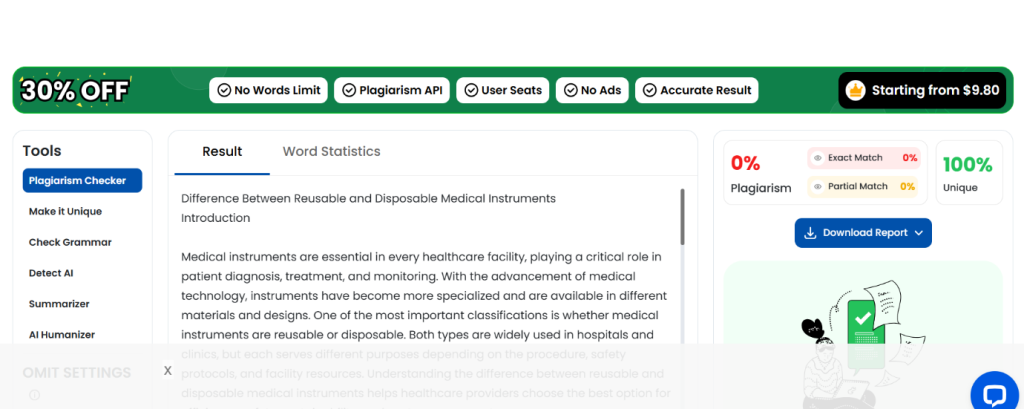
Medical instruments are essential in every healthcare facility, playing a critical role in patient diagnosis, treatment, and monitoring. With the advancement of medical technology, instruments have become more specialized and are available in different materials and designs. One of the most important classifications is whether medical instruments are reusable or disposable. Both types are widely used in hospitals and clinics, but each serves different purposes depending on the procedure, safety protocols, and facility resources. Understanding the difference between reusable and disposable medical instruments helps healthcare providers choose the best option for efficiency, safety, sustainability, and cost management.
Reusable medical instruments are tools specifically manufactured to withstand multiple uses. They are made from strong, durable materials such as stainless steel, titanium, and high-grade polymers. After each use, they must go through a strict cleaning and sterilization process to remove any contaminants. This ensures that they are safe and ready for use on the next patient. Examples of reusable medical instruments include surgical scissors, clamps, biopsy forceps, endoscopes, and many operating room tools.
Reusable instruments are commonly used in settings where precision and reliability are critical. They provide better performance during complex surgeries because they are manufactured to maintain sharpness, structure, and balance over a long lifespan.
Disposable medical instruments are designed for a single use. After completing a medical procedure, these instruments are discarded to prevent any possibility of contamination. They are usually made from plastic, silicone, or lightweight metals. Examples include disposable syringes, scalpels, catheters, surgical gloves, IV sets, and lancets.
Disposable instruments have grown significantly in popularity, especially during global health concerns like the COVID-19 pandemic. By eliminating the need for sterilization, disposable instruments help reduce the spread of infections and support faster patient care in emergency and outpatient settings.
The primary difference between reusable and disposable medical instruments lies in their design purpose. Reusable instruments are built for long-term use, requiring regular maintenance. Disposable instruments focus on safety and convenience by avoiding the need for reuse.
Reusable instruments have a higher initial purchase cost. However, because they can be sterilized and used repeatedly over several years, their overall cost becomes more economical in the long run. They are especially beneficial for facilities that handle large surgical workloads and have proper sterilization infrastructure.
In contrast, disposable instruments cost less at the time of purchase, but since they are thrown away after one use, healthcare facilities must continuously restock them. This can increase expenses over time, especially in high-volume departments. Additionally, disposing of medical waste requires additional effort and proper waste management systems, which can impact environmental sustainability.
Durability and precision also differentiate the two categories. Reusable tools are engineered to maintain accurate performance over time, making them essential in delicate procedures. Disposable instruments may not always provide the same level of precision but are ideal for standard or short procedures where infection control is a bigger priority.
From an infection control perspective, disposable medical instruments provide an advantage because they eliminate the risk of cross-contamination. Reusable instruments must be handled by highly trained staff following strict sterilization protocols. Any lapse in cleaning can lead to serious infection risks for patients.
Reusable medical instruments offer a wide range of benefits to hospitals:
These features make reusable instruments an essential part of operating rooms, intensive care units, and specialty departments.
Healthcare facilities also rely heavily on disposable instruments due to several important advantages:
These qualities support patient safety and simplify care in busy medical environments.
When choosing between reusable and disposable medical instruments, healthcare facilities must consider:
For example, complex surgeries may require reusable tools for high precision, while outpatient clinics may prefer disposable instruments to speed up patient service.
Reusable and disposable medical instruments both play vital roles in healthcare. Reusable instruments offer durability, long-term savings, and high-quality performance, especially in surgical environments. Disposable instruments provide excellent safety, convenience, and infection control, making them ideal for routine procedures and emergency care. Rather than choosing one type over the other completely, most hospitals benefit from a balanced approach based on patient needs, safety protocols, and operational resources. By selecting the right instrument type for each situation, healthcare providers can improve treatment quality, prevent infections, and enhance overall efficiency in medical services.
If you are unable to find your desired product on our website, please don’t hesitate to contact us through the Contact Form. Our team will be happy to assist you with product availability, custom requests, or further information.
Agree Decline